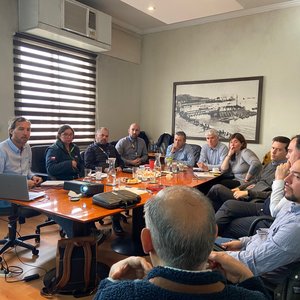Robert B. Gagosian is to step down as president and director of Woods Hole Oceanographic Institution (WHOI), a position he has held since 1994. Citing interests to advocate for the importance of ocean science at the national and international levels, and fulfillment of a seven-year strategic plan for the institution, Gagosian noted that he is “looking forward to moving to a role of broader impact to advance oceanography.”
James R. Luyten, 64, formerly director of research and executive vice president, has been appointed acting director by the institution’s Board of Trustees executive committee. Both moves are effective July 17, 2006. Gagosian will assume the title president emeritus.
James Moltz, chairman of the Board of Trustees noted that Gagosian, 61, had “fulfilled his seven-year plan,” including the creation of the Ocean Institutes, completing the Quissett campus redevelopment and new laboratories project, launching the new coastal research vessel, Tioga, securing funding to replace the 42-year old research submarine, Alvin, and completing 75 percent of the institution’s current campaign by raising $150 million.
“Bob’s innovative and energetic leadership has brought WHOI to new highs in research activities, physical facilities, and financial strength,” Moltz said. “We owe him a lot.”
“I am proud of the many accomplishments we have achieved together,” Gagosian said. “It has been a privilege to serve the institution in a time of remarkable growth and expansion, and in a time when science is challenged by other priorities in Washington. I am confident that with seasoned guidance from Jim Luyten and the board, a skilled leadership team will be assembled to take the institution to the next level.”
Luyten has agreed to serve as acting director for the duration of the search for a successor to Gagosian, which is expected to take at least 12 months.
Robert B. Gagosian was appointed director of Woods Hole Oceanographic Institution in 1994, following a career as a marine geochemist that included chair of the WHOI Marine Chemistry and Geochemistry department, six years as WHOI director of research and two as a senior associate director.
He joined WHOI in 1972 as an assistant scientist, studying substances produced by marine organisms and their transformation as they disperse through the water column to the seafloor. His research led to the discovery of the importance of the atmosphere as a transport mechanism for land-derived material to the open ocean. He is the author or co-author of some 85 scientific papers and several technical reports.
Dr. Gagosian holds a bachelor’s degree in chemistry from the Massachusetts Institute of Technology, and a PhD degree in organic chemistry from Columbia University. He held a National Institutes of Health postdoctoral fellowship at the University of California Berkeley before moving to Woods Hole. He is a Fellow of the American Academy of Arts & Sciences and the Explorers Club, has honorary degrees from Northeastern University and Long Island University, and has served on a variety of visiting committees and research panels for the National Science Foundation, the Office of Naval Research, and universities and research organizations in the U.S. and internationally.
James R. Luyten was appointed director of research in 1994 and executive vice president in 2002. He previously held a series of administrative positions, including chair of the WHOI Physical Oceanography department. He came to the institution in 1968 as a summer fellow in geophysical fluid dynamics and joined the staff as an assistant scientist in 1971. His area of research is the observation and modeling of ocean currents, including the general circulation of the North Atlantic, the Gulf Stream, and equatorial current systems. Dr. Luyten holds an AB degree from Reed College in chemistry and physics, and, from Harvard University, a master’s degree in physics and a PhD degree in chemical physics.
Woods Hole Oceanographic Institution (www.whoi.edu) is the largest private, independent marine research and engineering, and higher education organization in the United States. The mission of the Institution is to advance understanding of the oceans and their interaction with the Earth as a whole, and to communicate a basic understanding of the ocean's role in the changing global environment. It operates three ocean-going research vessels and the deep-diving submersible Alvin, which has contributed significantly to modern understanding of the ocean floor. The Institution also conducts a joint graduate education program with the Massachusetts Institute of Technology.










